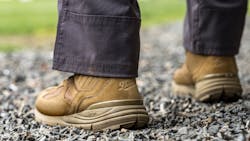How to Select Off-duty Footwear
When law enforcement professionals are on duty, their selection of footwear is controlled by several considerations: department dress code, issued uniform standards, working environment and (sometimes) simple long term comfort. Day work, court and plainclothes assignments usually mean highly shined black leather, commonly known as “low quarters” or simply dress shoes. For evenings and midnights, special assignments, cold weather work and more, boots are often selected or specified both for warmth and support/protection. Even with all of these controlling factors impacting on-duty footwear selection, there are a plethora of options to be considered: manufacturer, construction, materials, height, sole, inserts, etc. As vast as that selection may be, it doesn’t hold a candle to the choices you face in selecting your off-duty footwear.
None of us is very good at ignoring our duty or the call to serve; otherwise, we wouldn’t be in uniform in the first place. So, when you’re off-duty, not at the beach, and just going about enjoying your relax time, what’s on your feet? Do you even give it much thought? As you get dressed for the day with your family or friends and pull shoes/boots out of your closet, do you give any consideration to what your feet might face in the day?
The reality is that our feet need the same support and protection off-duty as they do on-duty, taking reasonable comfort and long-term wearability into concern. How does your selection of footwear adequately support that need? Our challenge is that most off-duty footwear tends to be bought in warehouse-type stores after we’ve tried them on, walked around in them for a few steps and decided we like how they look. We neglect to consider or answer some important questions and often end up not purchasing what we actually need. What should we be taking into consideration?
The type of shoe or boot is first
Are you buying a shoe for running? Hiking? Boating? The gym? Crossfit? All of those activities require a different type of footwear and if you don’t know the intended purpose beforehand, you really are wasting both your time and money. That doesn’t even take into consideration the potential harm you could cause your feet. Once you’ve identified what kind of footwear you’re actually on the search for, do you know enough about how the footwear is constructed to know what you’re looking for to ensure quality?
Consider what you need in what kind of shoe
Running shoes need to be as light as possible and really only serve to protect the sole of your foot from the surface you’re running on. The outsole is usually very fluffy (air-filled) and lightweight. The insole is usually pretty thin and made of a spongy material. The upper is made of a lightweight, often mesh material, and there is no toe cap or shank, and very little heel cup if any. More often than not, these shoes are created in bright neon colors or designs.
What about for cross-training or regular walking? Usually, these shoes are a little heavier than your running shoes but essentially serve the same purpose. The uppers are usually pretty lightweight, and the soles—both of them—are still just as air-filled to offer as much springy comfort as possible. There’s usually still no toe cap because none is needed for walking or running, or the mix of both, but there may be a shortened or reduced heel cup. The thought is that with longer walks or mixing walking and running there’s a greater chance of the heel moving around and to help anchor it in place the heel cup is designed in.
For hiking, you need a bit more support and protection. While the uppers on a pair of hiking shoes/boots can be anything from regular (below ankle) height to well over the ankle—at 6, 7, or 8-inches high—and made of heavier materials. The outsole and inner sole are both usually thicker and may include a shank. Depending on whether the manufacturer is going for lighter weight or greater protection the shank could be anything from polycarbonate to steel. Where running or walking shoe uppers are most often made from mesh or lightweight fabric, hikers usually incorporate leather, suede or heavier canvas materials. The uppers are often a hybrid mix of materials with eyelets that are reinforced so the laces can’t tear through. Some hiking boots will also incorporate a type of waterproof or water-resistant liner but also maintain some breathability.
Those three types of shoes/boots cover the most common designs used for off-duty. Obviously, there are even lighter weight and less protective designs and those are usually used for environments where water exposure is to be expected. Commonly referred to as boat or water shoes, they’re designed mostly to protect the sole of the foot from burns or puncture/abrasion damage.
At the other end of that spectrum are the boots designed for even greater abuse and protection. Such boots would be heavier than the average hiking boot, incorporating thicker leather, reinforced eyelets, toe caps, heel cups, and serious shanks. Many, if not most, of these boots, are also better insulated for protecting the feet from cold and lined to protect from water invasion.
That’s not to say that you can’t use these boots for hiking, backpacking, etc. That’s why, in fact, most of the major boot manufacturers make various designs and models with different levels of protection, water-proofing, colors, and materials. Some of the best boots for hiking and outdoor work are those designed for duty in similar circumstances.
Basic Terms and the Parts They Describe
The upper is the material above the sole that wraps your foot and/or ankle when the shoe is worn. It can be made from a variety of materials including leather, canvas, nylon, mesh and more and is comprised of other parts that can be named in more detail, e.g. the vamp, the heel, the eyelets, tongue, etc. The important thing to know is that it is the main body of the shoe and is what offers protection to most of your foot and support to your ankle (depending on the height of the footwear).
The outsole is the bottom of the shoe. It’s the part that comes in contact with the ground and can be designed from a wide variety of materials and include an equally wide variety of grip tread patterns. The combination of material and tread pattern ultimately determine just how much traction the sole provides.
The insole is the inside part of the shoe that the bottom of your foot contacts when the shoe is worn. It can be removable or not dependent on the design and additional insole material, pads and liners can be purchased aftermarket.
The remaining three design features we need to mention are purely protective in their function and don’t even exist in many running, cross training and hiking shoes. They are the toe cap, heel cup, and sole shank. The toe cap can be made from stiff materials such as formed leather or from seriously hard and strong materials like steel. The heel cup is the same way and the shank is a flat piece found between the insole and the outsole that protects your foot from punctures if you step on something sharp. Shanks can be made from plastics or metal and can be partial length, from heel to ball of the foot, or full length, running from heel to toe.
About the Author
Lt. Frank Borelli (ret), Editorial Director
Editorial Director
Lt. Frank Borelli is the Editorial Director for the Officer Media Group. Frank brings 20+ years of writing and editing experience in addition to 40 years of law enforcement operations, administration and training experience to the team.
Frank has had numerous books published which are available on Amazon.com, BarnesAndNoble.com, and other major retail outlets.
If you have any comments or questions, you can contact him via email at [email protected].

